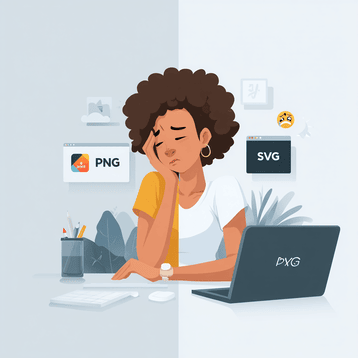


I’ve worked with both SVG and PNG formats for years—here’s how I choose the right one for logos, photos, or web graphics.
I’ve spent the last few years juggling between image formats for everything—logos, blog graphics, UI elements, and even those subtle background visuals you almost forget are there. And every time I found myself choosing between SVG and PNG, it felt like a mini-debate in my head.
If you’re stuck trying to figure out which one to go with, I’ll make it easier based on what I’ve experienced.
The first time I used an SVG was for a logo on a responsive website. No matter how much I resized the page or viewed it across different devices, it stayed crystal clear. That’s because SVGs are vector-based, which means they’re made from paths—not pixels. So they don’t blur, stretch weirdly, or look fuzzy when blown up.
Also, editing them is a breeze in tools like Illustrator. You can tweak colors, curves, and details directly in the code if you’re into that kind of thing. And the file size? Surprisingly small unless it’s a super complex design.
But it’s not all perfect. I tried using SVGs for a detailed infographic once—it was a mess. The file got heavy, rendering was slow on some browsers, and I had to switch back to PNG halfway through the project.
PNG feels like that reliable friend you always come back to. It’s not the fanciest, but it gets the job done—especially when you’re dealing with photos, graphics with lots of colors, or anything that needs transparent backgrounds.
I’ve used PNGs for social media banners, screenshots, and any image that had gradients or soft edges. And let’s be honest, not all clients (or browsers) are ready to support SVGs. PNG just works… everywhere.
That said, PNGs can be chunky. I’ve had to compress them often just to make sure my pages don’t take forever to load. They’re not ideal when you’re trying to keep your site super lightweight.
Here’s how I personally decide:
SVG for logos, icons, UI illustrations, anything that needs to be scalable, interactive, or animated.
PNG for static images, screenshots, or when I want pixel-perfect quality on detailed visuals.
Also, if I know the project involves older browsers or devices, I lean toward PNG to avoid compatibility issues.
So yeah, both formats have their strengths. I don’t think one is strictly better than the other—it really comes down to what you’re trying to build or show. Over time, I’ve just learned to match the format with the context. That’s what makes the difference.
Image Credit: microstock.in
